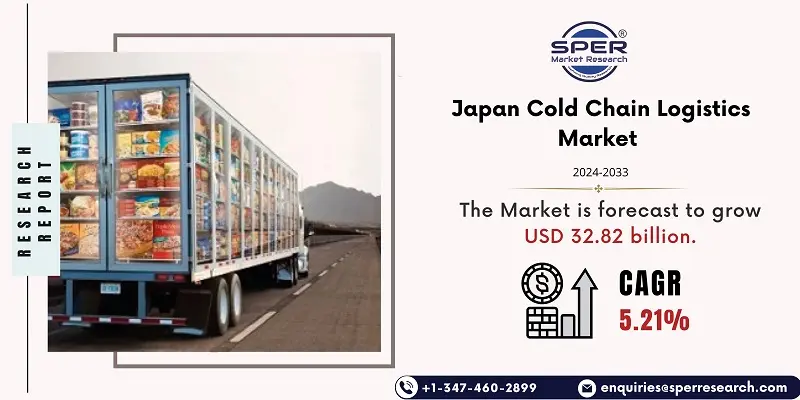
Japan Cold Chain Logistics Market Growth, Size, Trends, Demand, Revenue and Future Outlook
Japan Cold Chain Logistics Market Size- By Service, By Temperature Type, By Application- Regional Outlook, Competitive Strategies and Segment Forecast to 2033
| Published: Jul-2024 | Report ID: AMIN24162 | Pages: 1 - 107 | Formats*: |
| Category : Automotive & Transportation | |||
- April 2023; GLP has started the development of 55,000 square meters SQM of completely refrigerated cool storage spaces in Japan. GLP Pte Ltd GLP will be the carefully designed strategies improvement in Japan for GLP KOSHIOSHIMA and GLP ROKKO V to satisfy the developing needs of the worldwide virus chain industry.
- December 2022; DHL Production network reported its organization for coordinated factors tasks with Hologic Japan, Inc., a worldwide clinical gadget organization. The organizations reported the send-off of the administrations at Sagamihara Planned operations Place. Sagamihara Coordinated operations Community offers the ideal area in Hologic's clinical gadget completed products strategies network due to its nearness to East Japan.


| Report Metric | Details |
| Market size available for years | 2020-2033 |
| Base year considered | 2023 |
| Forecast period | 2024-2033 |
| Segments covered | By Service, By Temperature Type, By Application |
| Regions covered | Kanto Region, Kansai/Kinki Region, Central/ Chubu Region, Kyushu-Okinawa Region, Tohoku Region, Chugoku Region, Hokkaido Region, Shikoku Region. |
| Companies Covered | ITOCHU Logistics Corp., Kagome Co., Ltd., Kagoshima Transport Co., Ltd., Kintetsu World Express, Inc. (KWE), Kuroneko Yamato, Mitsubishi Logistics Corporation, Nichirei, Logistics Group Inc., Nippon Express Co., Ltd., Sankyu Inc., Yamato Holdings Co., Ltd. |
- Pharmaceutical Companies
- Food and Beverage Distributors
- Retailers (Supermarkets, Convenience Stores)
- Logistics and Transportation Companies
- Cold Storage Providers
- Government and Regulatory Agencies
- Healthcare Institutions
- Technology Providers
| By Service: |
|
| By Temperature Type: |
|
| By Application: |
|
- Japan Cold Chain Logistics Market Size (FY’2024-FY’2033)
- Overview of Japan Cold Chain Logistics Market
- Segmentation of Japan Cold Chain Logistics Market by Service (Storage, Transportation, Value-added Services.)
- Segmentation of Japan Cold Chain Logistics Market by Temperature Type (Chilled, Frozen.)
- Segmentation of Japan Cold Chain Logistics Market by Application (Horticulture, Dairy Products, Meats, Fish and Poultry, Processed Food Products, Pharma, Life Sciences and Chemicals, Others)
- Statistical Snap of Japan Cold Chain Logistics Market
- Expansion Analysis of Japan Cold Chain Logistics Market
- Problems and Obstacles in Japan Cold Chain Logistics Market
- Competitive Landscape in the Japan Cold Chain Logistics Market
- Impact of COVID-19 and Demonetization on Japan Cold Chain Logistics Market
- Details on Current Investment in Japan Cold Chain Logistics Market
- Competitive Analysis of Japan Cold Chain Logistics Market
- Prominent Players in the Japan Cold Chain Logistics Market
- SWOT Analysis of Japan Cold Chain Logistics Market
- Japan Cold Chain Logistics Market Future Outlook and Projections (FY’2024-FY’2033)
- Recommendations from Analyst
1.1. Scope of the report1.2. Market segment analysis
2.1. Research data source2.1.1. Secondary Data2.1.2. Primary Data2.1.3. SPER’s internal database2.1.4. Premium insight from KOL’s2.2. Market size estimation2.2.1. Top-down and Bottom-up approach2.3. Data triangulation
4.1. Driver, Restraint, Opportunity and Challenges analysis4.1.1. Drivers4.1.2. Restraints4.1.3. Opportunities4.1.4. Challenges4.2. COVID-19 Impacts of the Japan Cold Chain Logistics Market
5.1. SWOT Analysis5.1.1. Strengths5.1.2. Weaknesses5.1.3. Opportunities5.1.4. Threats5.2. PESTEL Analysis5.2.1. Political Landscape5.2.2. Economic Landscape5.2.3. Social Landscape5.2.4. Technological Landscape5.2.5. Environmental Landscape5.2.6. Legal Landscape5.3. PORTER’s Five Forces5.3.1. Bargaining power of suppliers5.3.2. Bargaining power of buyers5.3.3. Threat of Substitute5.3.4. Threat of new entrant5.3.5. Competitive rivalry5.4. Heat Map Analysis
6.1. Japan Cold Chain Logistics Market Manufacturing Base Distribution, Sales Area, Product Type6.2. Mergers & Acquisitions, Partnerships, Product Launch, and Collaboration in Japan Cold Chain Logistics Market
7.1. Japan Cold Chain Logistics Market Size, Share and Forecast, By Service, 2020-20267.2. Japan Cold Chain Logistics Market Size, Share and Forecast, By Service, 2027-20337.3. Storage7.4. Transportation7.5. Value-added Services7.6. Others
8.1. Japan Cold Chain Logistics Market Size, Share and Forecast, By Temperature Type, 2020-20268.2. Japan Cold Chain Logistics Market Size, Share and Forecast, By Temperature Type, 2027-20338.3. Chilled8.4. Frozen
9.1. Japan Cold Chain Logistics Market Size, Share and Forecast, By Application, 2020-20269.2. Japan Cold Chain Logistics Market Size, Share and Forecast, By Application, 2027-20339.3. Horticulture9.4. Dairy Products9.5. Meats, Fish and Poultry9.6. Processed Food Products9.7. Pharma9.8. Life Sciences9.9. Chemicals
10.1. Japan Cold Chain Logistics Market Size and Market Share
11.1. Japan Cold Chain Logistics Market Size and Market Share By Region (2020-2026)11.2. Japan Cold Chain Logistics Market Size and Market Share By Region (2027-2033)11.3. Kanto Region11.4. Kansai/Kinki Region11.5. Central/ Chubu Region11.6. Kyushu-Okinawa Region11.7. Tohoku Region11.8. Chugoku Region11.9. Hokkaido Region11.10. Shikoku Region.
12.1. ITOCHU LOGISTICS CORP12.1.1. Company details12.1.2. Financial outlook12.1.3. Product summary12.1.4. Recent developments12.2. KAGOME CO. LTD.12.2.1. Company details12.2.2. Financial outlook12.2.3. Product summary12.2.4. Recent developments12.3. KAGOSHIMA TRANSPORT CO. LTD.12.3.1. Company details12.3.2. Financial outlook12.3.3. Product summary12.3.4. Recent developments12.4. KINTETSU WORLD EXPRESS, INC. (KWE)12.4.1. Company details12.4.2. Financial outlook12.4.3. Product summary12.4.4. Recent developments12.5. KURONEKO YAMATO12.5.1. Company details12.5.2. Financial outlook12.5.3. Product summary12.5.4. Recent developments12.6. MITSUBISHI LOGISTICS CORPORATION12.6.1. Company details12.6.2. Financial outlook12.6.3. Product summary12.6.4. Recent developments12.7. NICHIREI LOGISTICS GROUP INC12.7.1. Company details12.7.2. Financial outlook12.7.3. Product summary12.7.4. Recent developments12.8. NIPPON EXPRESS CO.LTD12.8.1. Company details12.8.2. Financial outlook12.8.3. Product summary12.8.4. Recent developments12.9. SANKYU INC.12.9.1. Company details12.9.2. Financial outlook12.9.3. Product summary12.9.4. Recent developments12.10. YAMATO HOLDINGS CO. LTD.12.10.1. Company details12.10.2. Financial outlook12.10.3. Product summary12.10.4. Recent developments
SPER Market Research’s methodology uses great emphasis on primary research to ensure that the market intelligence insights are up to date, reliable and accurate. Primary interviews are done with players involved in each phase of a supply chain to analyze the market forecasting. The secondary research method is used to help you fully understand how the future markets and the spending patterns look likes.
The report is based on in-depth qualitative and quantitative analysis of the Product Market. The quantitative analysis involves the application of various projection and sampling techniques. The qualitative analysis involves primary interviews, surveys, and vendor briefings. The data gathered as a result of these processes are validated through experts opinion. Our research methodology entails an ideal mixture of primary and secondary initiatives.



Frequently Asked Questions About This Report
PLACE AN ORDER
Year End Discount
Sample Report
Pre-Purchase Inquiry
NEED CUSTOMIZATION?
Request CustomizationCALL OR EMAIL US
100% Secure Payment






Related Reports
Our Global Clients
Our data-driven insights have influenced the strategy of 200+ reputed companies across the globe.




















